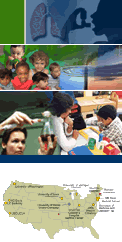Site Navigation
 |
Research Project Search
 |
Video Highlights
For audio and video clips featuring the Children's Centers, visit the Multimedia section. |

For many reasons, children are likely to be more vulnerable than adults to the effects of environmental contaminants. To better understand the effects of these exposures on children's health, the Centers for Children's Environmental Health and Disease Prevention Research ("Children's Centers") were established to explore ways to reduce children's health risks from environmental factors. The program is jointly funded by EPA through the Science to Achieve Results (STAR) grants program, and the National Institute of Environmental Health Sciences (NIEHS) with additional expertise and low-cost laboratory services provided by the Centers for Disease Control and Prevention (CDC).
The long-range goals of the program include understanding how environmental factors affect children's health, and promoting translation of basic research findings into intervention and prevention methods to prevent adverse health outcomes. The program is designed to foster research collaborations among basic, clinical, and behavioral scientists with participation from local communities.
Research
Researchers at the Children's Centers continue to publish significant research results. For example, researchers found that exposure to certain pesticides can be linked to small head circumference and low birthweight, and that Integrated Pest Management (IPM) is effective in reducing children's pesticide exposure.
News
 Indoor Air Particles Increase Asthma Symptoms in Children
Indoor Air Particles Increase Asthma Symptoms in ChildrenResearchers at Johns Hopkins found a direct correlation between increasing concentrations of particulate matter (PM) in indoor air and increased asthma symptoms in preschool children. Funded in part by a grant from EPA’s Science to Achieve Results program and the National Institute of Environmental Health Sciences (NIEHS), the study, published in the February issue of Environmental Health Perspectives, evaluated 150 inner city children with asthma in the Baltimore metropolitan area.
[Read More]
NIEHS and EPA have jointly issued two funding opportunities to support the next phase of the Children’s Environmental Health Research Centers (CEHCs) program.
[Read More]
 EPA Knows More about Children's Environmental Health Than Ever
EPA Knows More about Children's Environmental Health Than EverEPA has published a research summary report called: A Decade of Children’s Health Research. This report summarizes important research findings found from $127 million invested in research grants on children’s environmental health in response to an executive order issued in 1997.
[Read More]
For this, and other articles about the centers, see the Newsroom.
- Find a list of significant published research results in the Results section.
- Visit the Education Factsheets and Multimedia sections to view outreach materials, including videos.
- Local Community Partnerships are integral to the work of the Centers, supporting research, educational outreach, and intervention projects.
![[logo] US EPA](https://webarchive.library.unt.edu/eot2008/20090304232318im_/http://www.epa.gov/epafiles/images/logo_epaseal.gif)


